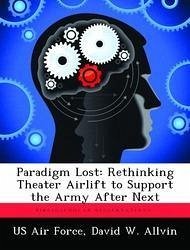Colonel Allvin analyzes the theater airlift implications for the United States Army's vision, Army After Next (AAN)-now called the Army Vision: The Transformation of the Army, which is a continuum of the AAN-for land warfare in the twenty-first century. He identifies theater airlift capabilities critical to the AAN concept and examines emerging systems that seem likely to furnish those capabilities. He argues that improvements in cargo-handling, situational awareness, and defensive systems-as well as the ability to operate in austere conditions-constitute the most crucial future requirements for theater airlift. Colonel Allvin concludes that the most promising emerging systems for achieving required theater airlift capabilities include the tilt-wing concept, autonomous cargo-handling systems, and a standoff capability for examining the suitability of opportune landing sites This work has been selected by scholars as being culturally important, and is part of the knowledge base of civilization as we know it. This work was reproduced from the original artifact, and remains as true to the original work as possible. Therefore, you will see the original copyright references, library stamps (as most of these works have been housed in our most important libraries around the world), and other notations in the work. This work is in the public domain in the United States of America, and possibly other nations. Within the United States, you may freely copy and distribute this work, as no entity (individual or corporate) has a copyright on the body of the work. As a reproduction of a historical artifact, this work may contain missing or blurred pages, poor pictures, errant marks, etc. Scholars believe, and we concur, that this work is important enough to be preserved, reproduced, and made generally available to the public. We appreciate your support of the preservation process, and thank you for being an important part of keeping this knowledge alive and relevant.
Bitte wählen Sie Ihr Anliegen aus.
Rechnungen
Retourenschein anfordern
Bestellstatus
Storno





